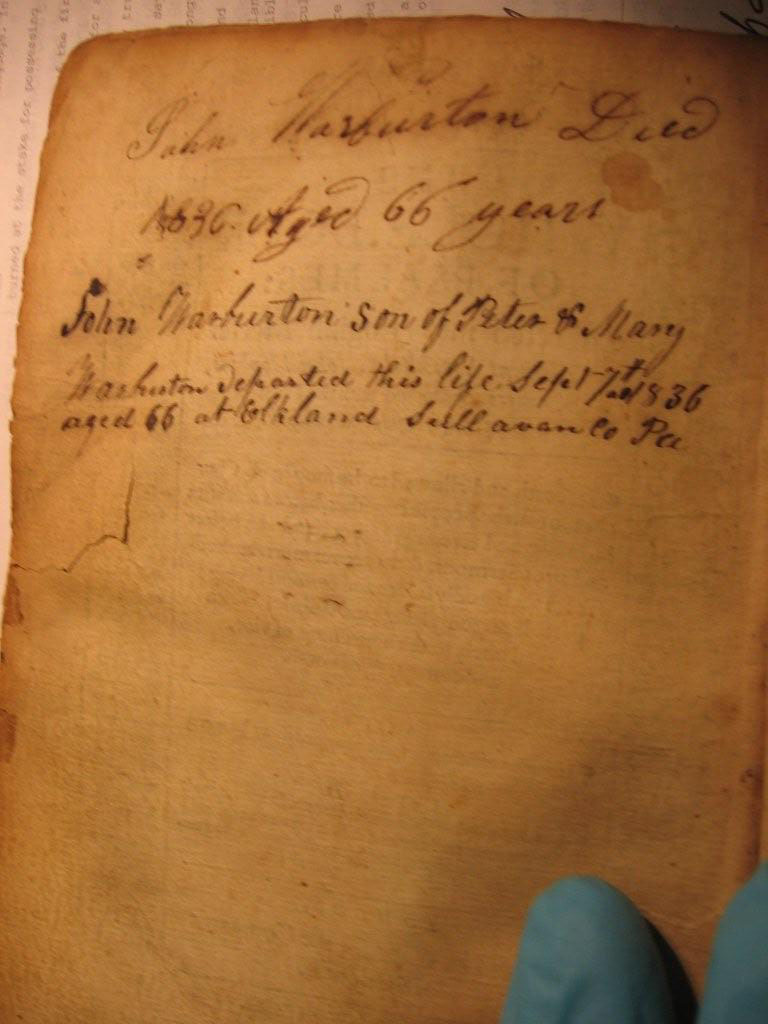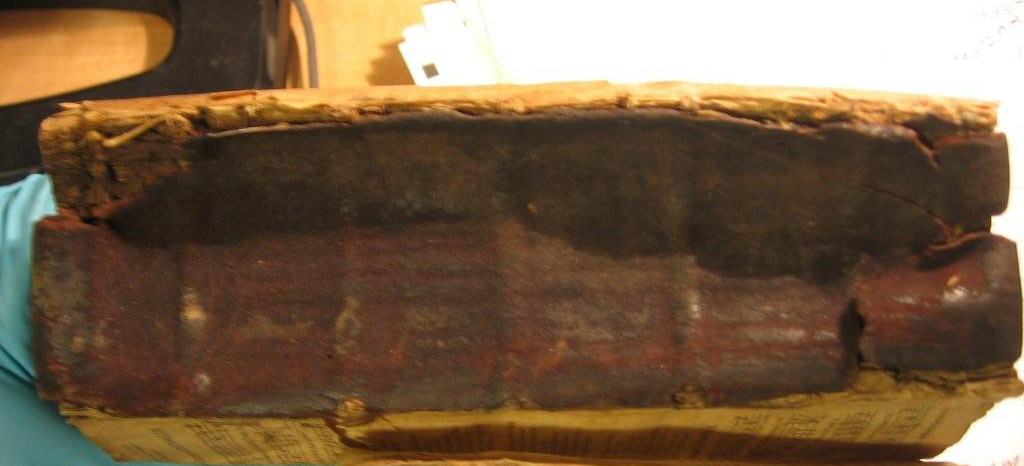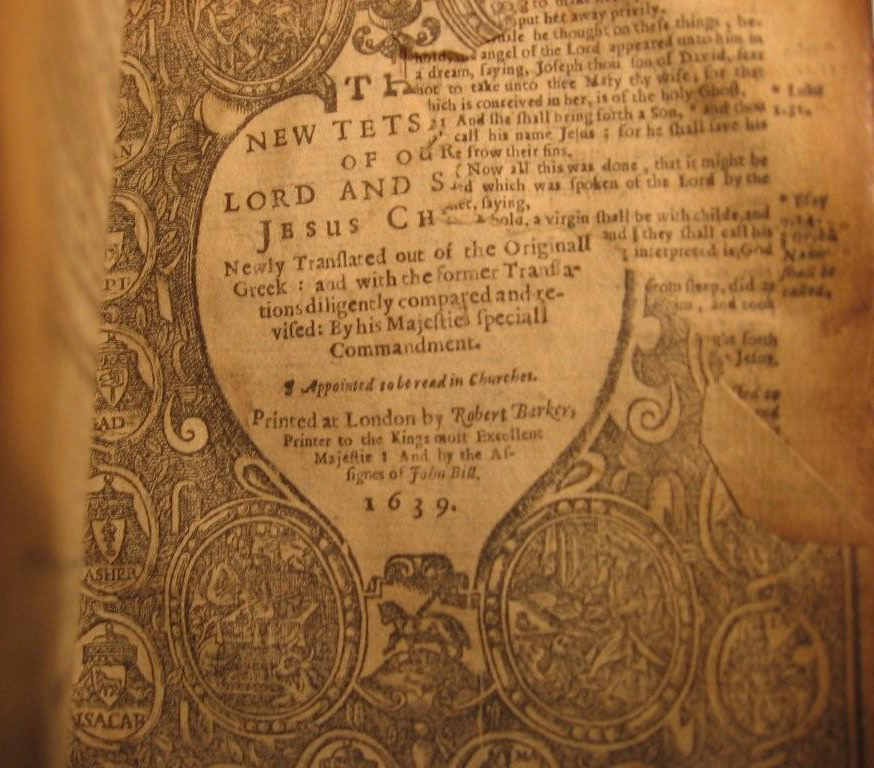George Robert Warburton of Clyde, Kansas, has in his possession and old battered bible that serves as a Warburton family heirloom gong back to the middle 17th century. As detailed in Settlers LIII: Descendants of John and Mary (Sadler) Warburton, by Lyle Rockwell and Larry Pardoe, this Warburton family is one of two old Warburton families to have emigrated from England to Sullivan County, PA in the early 1800s. While their roots go back to the 1600s and earlier, to date, a specific connection between the two families has not been established. The Warburtons who retained and passed down the old family bible are the ancestors, contemporaries and descendants of John and Mary, including George. This page attempts to tell what we know about the bible and its history and to provide a brief pictorial history of what it contains.
George is actually the great great grandson of the emigrant couple. In late 2008, George made what infomration he had, as well as a set of photographs, available to the Sullivan County Genealogical Web Page, for which we are immensely grateful. Bob Sweeney, the page administrator, who holds a doctorale in American history, analyzed the information and the photos and wrote the following comment to George on February 12, 2009:
I am about ready to start posting the photos of the bible and various comments on it. Let me tell you also that, from my own independent research, I have come to the conclusion that you have a rare 1639 version of the King James Bible that was authorized and first issued in 1611. You can read more about the historical context at this page: The English Bible.
You will note that your bible has a printing date of 1639 and is printed by Robert Barker, official printer to the King. He is the son of Christopher Barker, who preceded him in that capacity and was actually the official printer for Queen Elizabeth I. Further, the funds for printing the bible were forwarded to Barker by John Bill and colleagues, and you will see his name under that of Barker on your bible.
I will report this information in my write up, but I want you to know that the bible you have is indeed a priceless relic, mostly for historical reasons because there just are not many of those left around any more. It would certainly have been the case that anyone holding such a bible in their possession during the English Civil War in the mid-1600s could have been at risk depending on which side became aware of it. So, burying and attempts at burning your bible, as anecdotally related by your ancestors, was a real possibility, even if the stories handed down may be lacking in exact accuracy about age and circumstances.
As we relate the story of this Bible, we will provide a few photographic examples of its contents and external appearance. Then, at the end of the page, we'll offer a glossary of the contents as scanned and contributed by George Robert Warburton. We will also be presenting severfal photos taken from the Warburton Diary kept by John over the course of several years in the early 1800s. They throw some light on the Warburotn family and provide context for the Bible photos. Therefore, our first photo below is taken from the Diary and shows the death notice of John Warburton, who brought the Bible with his family to Elkland, in what would become Sullivan County, PA, in 1816. At that time, Elkland was practically a wilderness area in the northern reaches of what in those days was a much larger Lycoming County.

Death of John Warburton
Son of Peter and Mary (Molyneux) Warburton
Notice Inscribed in the Warburton Diary
September 7, 1836
Elkland, Sullivan County, PA
Photo Contributed by George Warburton
In fact, at this time, no one knows the exact location of the grave of John Warburton, the emigrant, although Bob Sweeney surmises that he is buried somewhere on the family homestead in Elkland. Here is a summary of the issues discussed by Bob, Larry Pardoe, Lyle Rockwell and George Warburton in March 2009:
From Larry:
I haven't found a burial location for the John Warburton (1770-1836) that was married to Mary Sadler (1783-1865). Mary apparently went west with son Peter as I see from George Warburton's genealogy that Mary and son Peter both died in Plymouth, Sheboygan Co., Wisconsin.
From the Lycoming Gazette, 21 Sept. 1836: "John Warburton, died at his residence in Elkland Twp., on the 8th inst., at an advanced age. He was among the earliest settlers in the county and has left a wife and large family."
This date is one day off from the September 7, 1836 date that George Warburton's genealogy shows. Not sure which date is right.
I would guess that perhaps John Warburton might have been buried on the family property. I think George Warburton, Lyle Rockwell and I have discussed where he might have been buried before but I can't remember exactly what we decided. If it was in a cemetery, it was probably an unmarked grave.
His son John Molyneux Warburton (1805-1874) is buried in Hillsgrove Cemetery.
Sorry nothing more. Wish I had the answer.
From George:
My biggest project in life is to find where John is buried.
I believe I know where the homestead was.
However there is doubt in my mind if he is buried there.
We know he left a large family and he was very religious.
The rest of the family have large head stones.
His son John M and others are buried at Hillsgrove.
I have a gut feeling that John is also.
I wonder if the Union church at Hillsgrove has records that go back that far?
I have been back there twice trying to find his grave.
Guess I looked too much but didn't ask the right questions.
Lyle or Larry do you know anything about the history of the church?
From Bob:
To the best of my knowledge, at the time of his death in 1836, the only functioning church in the area was the Peace Church, which was shared by the Irish and Germans—Catholic and Lutheran alike—until the Catholics got their own church going in the 1840s. The Peace church, located in Cherry Township, is a good distance from Hillsgrove or Elkland. In my view, he was likely buried on the family land, only because I doubt there was a formal church cemetery to use. If you know where the land is, George, then maybe the family would have used a large field stone or something of that kind to mark the location and we could actually find it. I’d be glad to help you look if we can pinpoint the property. There are no formal records for the Hillsgrove church going back that far.
From George:
The last time we we were back there we located the land from old land records. If the information I have is correct, it was located just south of John M. Warburton's land and Warburton Hollow. We stopped and had coffee with the owners. They gave us some history of the property but didn't have any land transactions from the past. We tried to obtain information from the old Lycoming Co records but we didn't get anywhere. I have it in the back of my mind that the first school house was also used as a church, but know where I got this idea. That would have been in 1816 and John helped build it. Back to the books. I'll have to check some of my old video and see what the earliest dates are on the head stone.
From George:
Could the cemetery have been there before the church? I just reviewed some old cam recorded film I took in 1992. It was of the Union Church cemetery. John Hill died 7-1-1831 and is buried there. Joseph Sadler ,brother in law of John, is buried there. He died in 1820. In the Warburton Diary, John tells of people coming from far away for this funeral and there was over 20 people present for Joseph's service. It's possible their bodies were transfered from some other grave but I doubt it. John died in 1836, so my bet is that he was also buried there. If there was a head stone, it has probably sunk into the ground on maybe there never was a head stone. There actually are head stones in the area of the Warburton graves that we couldn't read. I don't know if I could find out anything else by another trip back there. But that area of the country is so beautiful it's worth the trip just to see landscape again. Maybe this summer if I have another long trip in me.
From Lyle:
When you speak of John Hill, am I correct to assume that John Hill is the father of Susannah Hill, wife of Joseph Sadler? Since John Hill and Joseph Sadler are both buried in Hillsgrove (before 1836), then I would think that John Warburton would also be buried there. Have you any idea of the caretaker of the cemetery.?Sometimes, the records for the cemetery are handed down from generation to generation, and may show who is buried where. I used some old cemetery records to find one of my ancestors, who had no headstone, but was recorded as buried. The best way to find the present day caretaker is to call a local funeral home. They usually have who the contact person is for each cemetery.
The search goes on. We have also asked the Sullivan County Historical Society and Museum to help us out if they can. Stay tuned.
How was the Bible passed down and how did it come into the hands of Goerge Robert Warburton? Our source document on this information is a letter written on November 24, 1947 from Cora "Belle" Warburton, living in Cherokee, Oklahoma, to her nephew George Warburton, the father of our contributor, and his wife Ann (Huth) Warburton. George and Ann lived in Southern California at the time. You can read the letter itself at:
Aunt Belle's Letter: page 1
Aunt Belle's Letter: page 2
Courtesy of Lyle Rockwell, we can determine from this letter that the bible was passed down as follows:
Possessor # 1 George (1670-1735) & Mary Chantler Warburton
# 2 Their son Peter (1725-1794) & Mary Molyneux Warburton
# 3 Their son John (1770-1836) & Mary Sadler Warburton
# 4 Their son George Thomas (1826-1897) & Mary Jane Wright Warburton
# 5 Their daughter Cora "Belle" (1870-1951) Warburton
#6 Her nephew George Harry (1899-1973) & Ann Huth Warburton
#7 George's son George Robert (1930-___) & Lily L. Cook Warburton
Of course, the Bible had to be in someone's hands from its publication date in 1639 until it came into the hands of George and Mary (Chantler) Warburton in 1670. We presume that it was held by this George's father, name at this point unknown. We do know that his family of origin was living in Liverpool at the time he was born, but that he died and was buried in the Cheshire area in 1735.

Warburton Family Bible
Side Perspective
Photo Contributed by George Warburton
One of the issues discussed among the individuals exchanging history, photos and other records incidental to this page was the possible historical antecedents for the bible. For example, Lyle Rockwell made the followinng observations which help to establish why "bibles" and similar religious materials were potentially dangerous artifacts in 16th and 17th century England:
I would be interested to know if the Warburton Bible is the famed
Tyndale version of the bible that was ordered burned in the early
1500s. If so, it would indeed about be 500 years old as "Aunt Belle"
suggested in her letter to George & Ann!
William Tyndale was was burned at the stake for his translation of the
Scriptures into the English language. Here is what I found on the net:....
Persecution of the Bible
We are familiar with the fact that the English Reformer William
Tyndale was burned at the stake for his labours in seeking to provide
a faithful translation of the Scriptures in the English language. In
fact, Rome persecuted the translation and circulation of the
Scriptures in all the countries of the European Reformation. The
persecution was particularly fierce, however, in England and Scotland.
The threat of being put to death as a heretic did not extend merely to
translating the Scriptures into the English language, but also even to
reading or possessing such a translation or any part of it.
As Tyndale translated and published portions of Scripture in English,
it was eagerly taken up and read. Although many thousands of copies of
Tyndale's translation were printed, so fierce was the persecution that
only one complete copy of the first edition has survived the
systematic destruction ordered by the Romanist clerics. Tyndale knew
that the Roman Catholic authorities would go far beyond destroying the
printed copies of his translation: 'In burning the New Testament, they
did none other thing than I looked for; no more shall they do if they
burn me also, if it be God's will, it shall so be. Nevertheless in
translating the New Testament I did my duty and so do I now'.
England's Martyrs for the Word of God
The Bishop of London was not content merely with burning Tyndale's
Bible; many were hunted down simply for reading the Scriptures that
were now available in their own language. In England on 1 May 1532,
James Bainham was burned at the stake for possessing such a
translation. Addressing the crowd just before the lighting of the
fire, he exclaimed: "I come hither, good people! Accused and condemned
for an heretic... And these be the articles that I die for, which be a
very truth, and grounded on God's Word, and no heresy. They be these:
first, I say it is lawful for every man and woman, to have God's Book
in the mother tongue." In 1527, Tyndale himself was hunted down on the
continent, seized and ultimately put to death. His dying prayer was "Lord, open
the King of England's eyes". Within months of Tyndale's martyrdom, a complete English Bible,
two-thirds of it Tyndale's work, and licensed by Henry VIII, was
circulating in Britain.
Of course, we now know that the Warburton Family Bible was published about 100 years after the death of Tyndale. However, the "troubles" did not end with Henry VIII's publication of an "English language" bible. Henry himself was excommunicated by the Pope from the Catholic Church and founded his onw church, the Church of England. His henchmen and clerical authorities exercised the same intense persecution of Catholics and dissident members of other Protestant sects that had been carried out by the "Papists" before Henry came to power. From the 1530s until the Glorious Revolution in 1690, the battle for religous supremacy wound back and forth through English politics and society. In between, England experienced one king publicly executed, another driven from his throne, the Cromwell dictatorship, and a Civil War. All of these events had direct or indirect religious overtones and therefore any "reform" group could easily have been in jeopardy and wanted to conceal their religious documents. Such events as the Gunpowder Plot, an attempt to violently overthrow the entire English government by setting off explosive powder under Parliament, were but extreme cases of the religious and military conflict in England during those years. The Warburton Family Bible is a priceless historical relic of that era, as well as the era of emigration when the Warburtons and others like them lifet England for both commercial opportunity and the right to hold and express "heretical" beliefs. Clearly, the Warburtons viewed the book as a sacred heirloom, even attributing to it an aura of good luck for whoever would hold it. We are indebted to the family for its devotion to history and religious traditon in preserving this bible against all odds. We are honored to present it here for our readership.
Photos of the Bible and Selected Diary Pages
We are indebted to George Robert Warburton for taking the scans shown below and to Larry Pardoe for creating a CD-ROM based version of the photos from which Bob Sweeney has prepared the following pictorial record. Where possible and useful, we have added comments or transcriptions to go with each photo.

Warburton Diary
Frontal View

Warburton Family Bible
Whole Book of Psalmes

Warburton Family Bible
Psalms of David

Warburton Family Bible
Garden of Eden Page

Warburton Family Bible
Family Events Page

Warburton Family Bible
Family Events Page: Close-up View of Top

Warburton Diary
Two Pages of Commentary

Warburton Diary
Two Pages of Commentary: Close-Up of Right Page With Note on
Emigration Details

Warburton Diary
Sketch of Land on Old Handwritten Text: First View

Warburton Diary
Sketch of Land on Old Handwritten Text: Second View
Copyright © 2008 Robert
E. Sweeney and individual Contributors. All Rights Reserved. Prior written
permission is required from Robert E. Sweeney and individual Contributors before
this material can be printed or otherwise copied, displayed or distributed
in any form. This
is a FREE genealogy site sponsored through PAGenWeb and can be reached directly
at ~Sullivan County Genealogy Project (http://www.rootsweb.com/~pasulliv)
|

